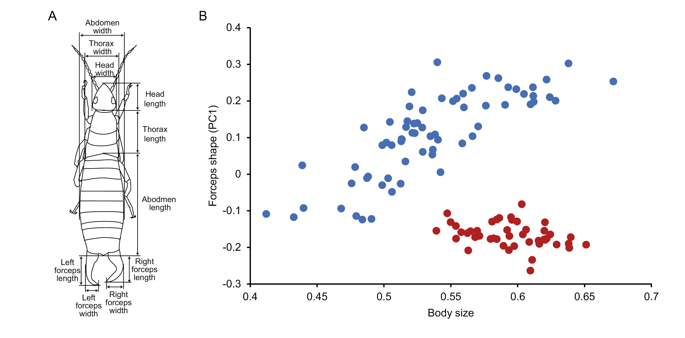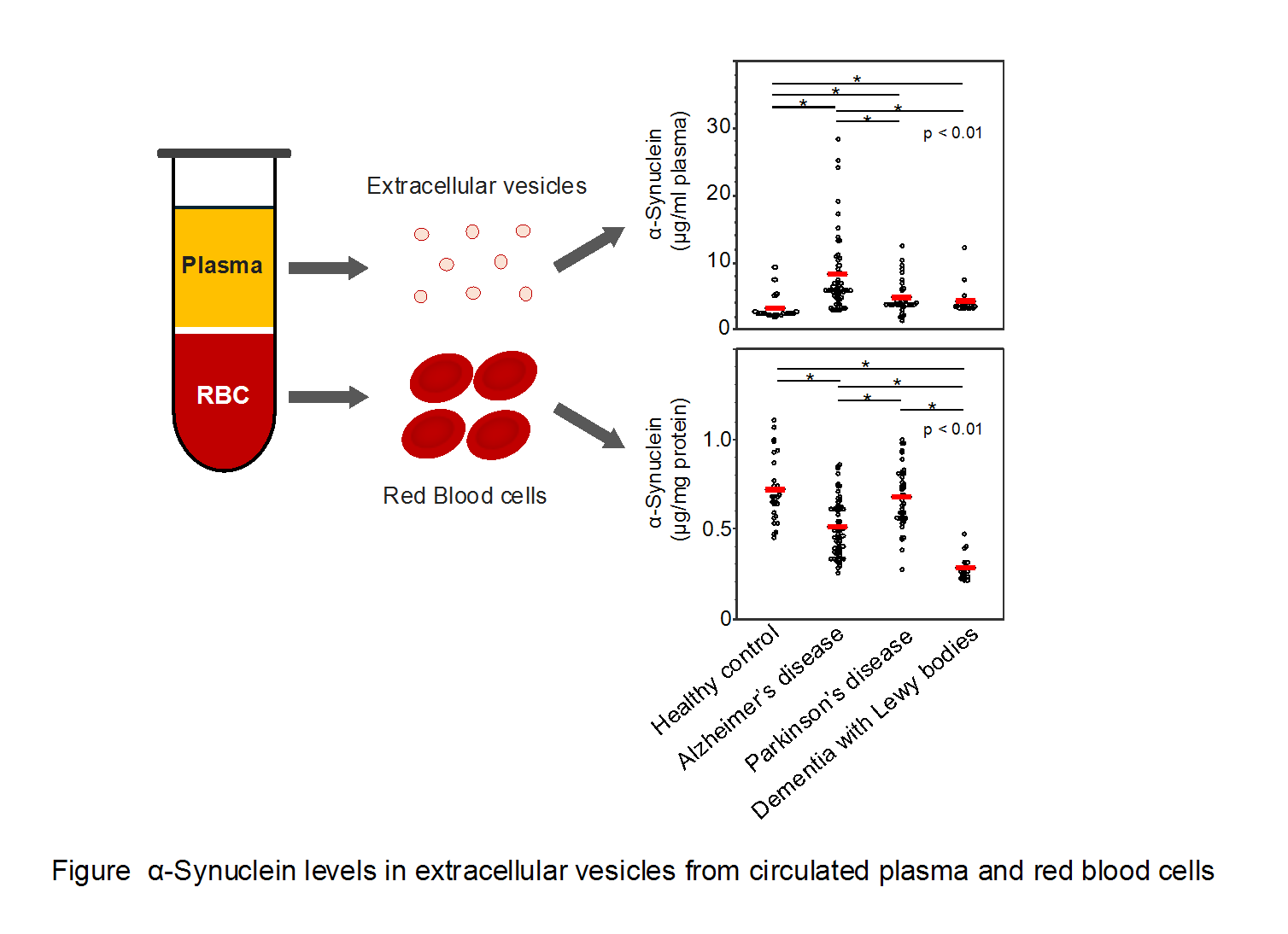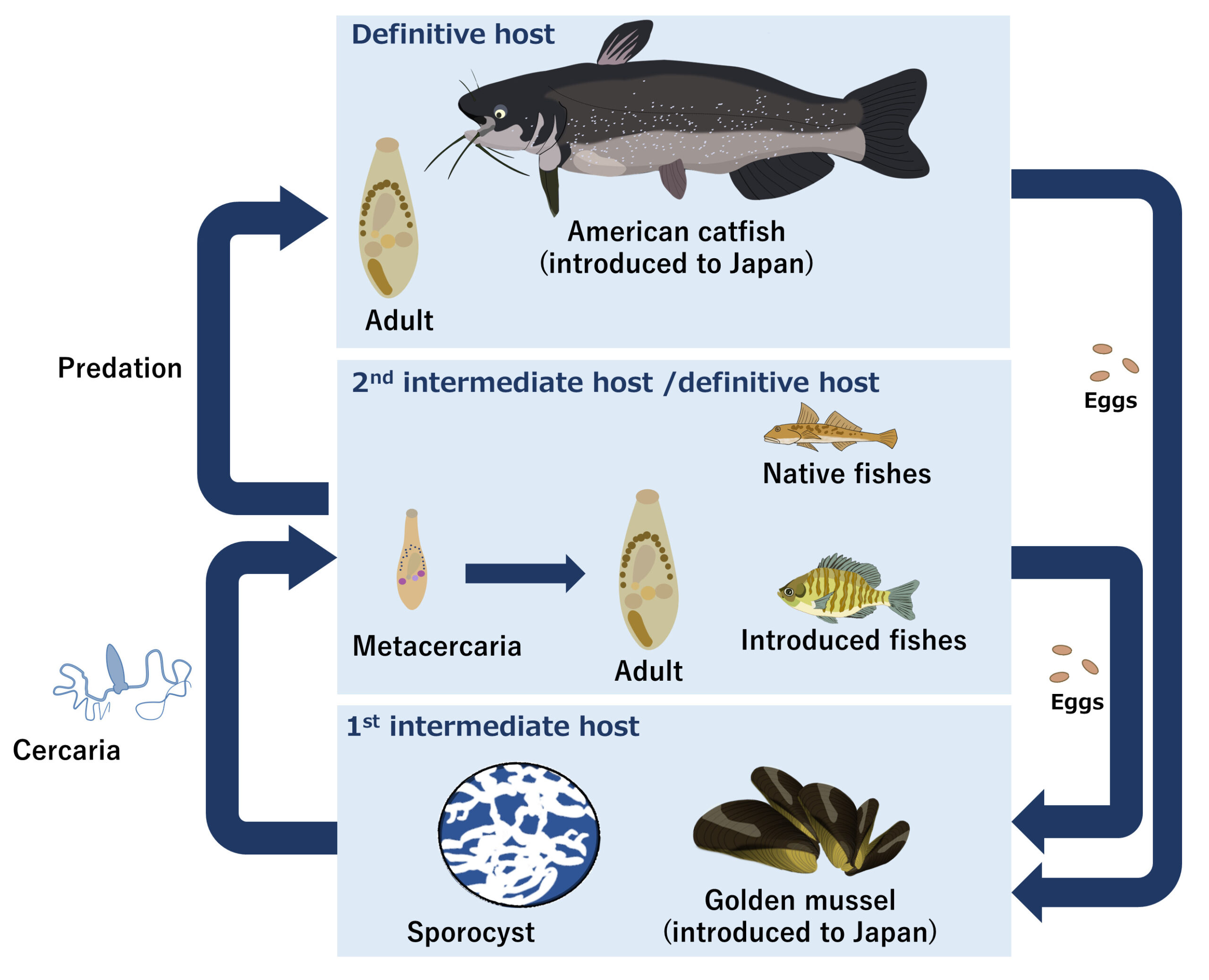September 7, 2021
The development of an algorithm that promptly normalizes disrupted neural activity in ADHD by the mechanism of chaotic resonance and the examination of the effect using a model simulation
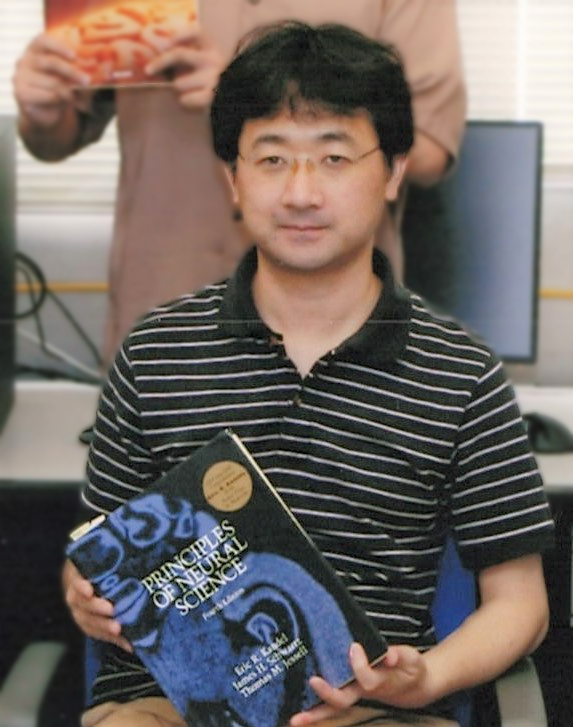
Department of Information Science
Faculty of Science
Toho University



Department of Information Science
Faculty of Science
Toho University
Research background
Attention deficit-hyperactivity disorder (ADHD) is a developmental disorder with high morbidity which is characterized by inattention and hyperactivity/impulsivity. Because ADHD has serious psychosocial effects on patient life, more effective treatment methods should be established [1]. Multiple dysfunctional neural processes, including a functional abnormality of the dopaminergic neural system, have been reported to cause ADHD [2]. However, due to complicated interactions in the neural bases, the pathological mechanisms of ADHD have not been fully elucidated. “Psychosocial treatment” and “drug therapy” are mainly used for the management of ADHD. On the other hand, neurofeedback techniques are among the new non-drug therapies that have recently drawn attention. Techniques to promote long-term changes in neural networks are assisted by real time feedback of information on neural activity of the brain detected by neuroimaging methods such as the electroencephalogram (EEG). The feedback technique that utilizes EEG has attracted attention as a treatment method to provide sustained symptom improvement in ADHD, as Lubar and Shouse demonstrated this technique may have some inhibitory effect on hyperactivity/impulsivity in 1976 [3]. Most of the various neurofeedback techniques proposed to date enhance synaptic plasticity of neural networks (explanation of terms (1)). Therefore, they require approximately several weeks of repeated training to achieve these changes.
Studies of the characteristics of neural networks in ADHD using neurophysiological measures, such as EEG and functional magnetic resonance imaging (fMRI), are currently being conducted. On the other hand, there are ongoing studies of the neural basis of ADHD in which the neurodynamics are described using a mathematical neural network model. For example, Baghdadi et al. created a simulation model of neural networks between the frontal and sensory cortices consisting of excitatory and inhibitory neurons that showed the transition of neural activity in the frontal cortex to chaos-chaos intermittency (CCI), by creating reduced coupling of pathways from the frontal cortex to the sensory cortex [4]. The behavior generated by the model (hereafter referred to as the Baghdadi model) shows a high consistency with attention deficit behavior in actual patients with ADHD [4-6].
Attention deficit-hyperactivity disorder (ADHD) is a developmental disorder with high morbidity which is characterized by inattention and hyperactivity/impulsivity. Because ADHD has serious psychosocial effects on patient life, more effective treatment methods should be established [1]. Multiple dysfunctional neural processes, including a functional abnormality of the dopaminergic neural system, have been reported to cause ADHD [2]. However, due to complicated interactions in the neural bases, the pathological mechanisms of ADHD have not been fully elucidated. “Psychosocial treatment” and “drug therapy” are mainly used for the management of ADHD. On the other hand, neurofeedback techniques are among the new non-drug therapies that have recently drawn attention. Techniques to promote long-term changes in neural networks are assisted by real time feedback of information on neural activity of the brain detected by neuroimaging methods such as the electroencephalogram (EEG). The feedback technique that utilizes EEG has attracted attention as a treatment method to provide sustained symptom improvement in ADHD, as Lubar and Shouse demonstrated this technique may have some inhibitory effect on hyperactivity/impulsivity in 1976 [3]. Most of the various neurofeedback techniques proposed to date enhance synaptic plasticity of neural networks (explanation of terms (1)). Therefore, they require approximately several weeks of repeated training to achieve these changes.
Studies of the characteristics of neural networks in ADHD using neurophysiological measures, such as EEG and functional magnetic resonance imaging (fMRI), are currently being conducted. On the other hand, there are ongoing studies of the neural basis of ADHD in which the neurodynamics are described using a mathematical neural network model. For example, Baghdadi et al. created a simulation model of neural networks between the frontal and sensory cortices consisting of excitatory and inhibitory neurons that showed the transition of neural activity in the frontal cortex to chaos-chaos intermittency (CCI), by creating reduced coupling of pathways from the frontal cortex to the sensory cortex [4]. The behavior generated by the model (hereafter referred to as the Baghdadi model) shows a high consistency with attention deficit behavior in actual patients with ADHD [4-6].
Research content
Nobukawa et al. confirmed the stabilization effect using the Baghdadi model by simulating sensory stimulation based on neural activity in the frontal cortex in ADHD. They further developed an algorithm that reduces the disruption of neural activity in the frontal cortex by providing feedback of the stimulation (see Figure 1). Specifically, they applied the “reduced region of orbit method” (RRO method) [7], a chaos control method proposed by Nobukawa et al., to neural activity in the frontal cortex, which was detected by neuroimaging methods such as EEG. They confirmed that the stimulation of the frontal cortex normalizes neural activity by transitioning to less temporal asynchrony, so-called chaotic resonance (explanation of terms (2)) (see Figure 2).
Nobukawa et al. confirmed the stabilization effect using the Baghdadi model by simulating sensory stimulation based on neural activity in the frontal cortex in ADHD. They further developed an algorithm that reduces the disruption of neural activity in the frontal cortex by providing feedback of the stimulation (see Figure 1). Specifically, they applied the “reduced region of orbit method” (RRO method) [7], a chaos control method proposed by Nobukawa et al., to neural activity in the frontal cortex, which was detected by neuroimaging methods such as EEG. They confirmed that the stimulation of the frontal cortex normalizes neural activity by transitioning to less temporal asynchrony, so-called chaotic resonance (explanation of terms (2)) (see Figure 2).
Future perspective
This study demonstrated the stabilization of neural activity by applying a feedback method, called RRO, to a simulation model of neurodynamics in ADHD. Sensory stimulation, such as photic stimulation, has recently been reported to improve attention [8,9]. This suggests a potential of clinical application of the neurofeedback method proposed in this study to such devices for attention control. In the conventional neurofeedback techniques based on the activation of neuropathways during synaptic plasticity, it takes several weeks to improve attention. However, once the method proposed in this study is established, the disruption of neural activity in ADHD should be normalized by prompt neurofeedback.
This study demonstrated the stabilization of neural activity by applying a feedback method, called RRO, to a simulation model of neurodynamics in ADHD. Sensory stimulation, such as photic stimulation, has recently been reported to improve attention [8,9]. This suggests a potential of clinical application of the neurofeedback method proposed in this study to such devices for attention control. In the conventional neurofeedback techniques based on the activation of neuropathways during synaptic plasticity, it takes several weeks to improve attention. However, once the method proposed in this study is established, the disruption of neural activity in ADHD should be normalized by prompt neurofeedback.
Explanation of terms
(1)Synaptic plasticity: A mechanism in which the function of synapses for signal transmission between neurons in the brain is enhanced by repeated learning and training.
(2)Chaotic resonance: Vast findings of stochastic resonance and the stochastic facilitation theory show that brain function is achieved by actively utilizing the variability in spatiotemporal neural activity. In our study, variability generated by brain dynamics is defined as chaos [10]. However, neural activity is not fully optimized in many mental illnesses. In this study, the Baghdadi model used for the description of the neurodynamics in ADHD also shows nonoptimized chaotic behavior. This study used the RRO method to show normal neurodynamics with chaos-chaos intermittency in transitioning to chaotic resonance that can be easily synchronized with the reference signal.
(1)Synaptic plasticity: A mechanism in which the function of synapses for signal transmission between neurons in the brain is enhanced by repeated learning and training.
(2)Chaotic resonance: Vast findings of stochastic resonance and the stochastic facilitation theory show that brain function is achieved by actively utilizing the variability in spatiotemporal neural activity. In our study, variability generated by brain dynamics is defined as chaos [10]. However, neural activity is not fully optimized in many mental illnesses. In this study, the Baghdadi model used for the description of the neurodynamics in ADHD also shows nonoptimized chaotic behavior. This study used the RRO method to show normal neurodynamics with chaos-chaos intermittency in transitioning to chaotic resonance that can be easily synchronized with the reference signal.
References
[1]Sonuga-Barke, Edmund J. S., et al. “Nonpharmacological interventions for ADHD: systematic review and meta-analyses of randomized controlled trials of dietary and psychological treatments.” American Journal of Psychiatry 170.3 (2013): 275-289.
[2]Sigurdardottir, H. L., et al. “Association of norepinephrine transporter methylation with in vivo NET expression and hyperactivity–impulsivity symptoms in ADHD measured with PET.” Molecular Psychiatry 26.3 (2021): 1009-1018.
[3]Van Doren, Jessica, et al. “Sustained effects of neurofeedback in ADHD: a systematic review and meta-analysis.” European Child & Adolescent Psychiatry 28.3 (2019): 293-305.
[4]Baghdadi, Golnaz, et al. “A chaotic model of sustaining attention problem in attention deficit disorder.” Communications in Nonlinear Science and Numerical Simulation 20.1 (2015): 174-185.
[5]Gonen-Yaacovi, Gil, et al. “Increased ongoing neural variability in ADHD.” Cortex 81 (2016): 50-63.
[6]Michelini, Giorgia, et al. “Shared and disorder-specific event-related brain oscillatory markers of attentional dysfunction in ADHD and bipolar disorder.” Brain Topography 31.4 (2018): 672-689.
[7]Nobukawa, Sou, and Natsusaku Shibata. “Controlling chaotic resonance using external feedback signals in neural systems.” Scientific Reports 9.1 (2019): 4990.
[8]Vandewalle, Gilles, et al. “Daytime light exposure dynamically enhances brain responses.” Current Biology 16.16 (2006): 1616-1621.
[9]Newman, Daniel P., et al. “Ocular exposure to blue-enriched light has an asymmetric influence on neural activity and spatial attention.” Scientific Reports 6 (2016): 27754.
[10]Nobukawa, Sou, and Haruhiko Nishimura. “Synchronization of chaos in neural systems.” Frontiers in Applied Mathematics and Statistics 6 (2020): 19.
[1]Sonuga-Barke, Edmund J. S., et al. “Nonpharmacological interventions for ADHD: systematic review and meta-analyses of randomized controlled trials of dietary and psychological treatments.” American Journal of Psychiatry 170.3 (2013): 275-289.
[2]Sigurdardottir, H. L., et al. “Association of norepinephrine transporter methylation with in vivo NET expression and hyperactivity–impulsivity symptoms in ADHD measured with PET.” Molecular Psychiatry 26.3 (2021): 1009-1018.
[3]Van Doren, Jessica, et al. “Sustained effects of neurofeedback in ADHD: a systematic review and meta-analysis.” European Child & Adolescent Psychiatry 28.3 (2019): 293-305.
[4]Baghdadi, Golnaz, et al. “A chaotic model of sustaining attention problem in attention deficit disorder.” Communications in Nonlinear Science and Numerical Simulation 20.1 (2015): 174-185.
[5]Gonen-Yaacovi, Gil, et al. “Increased ongoing neural variability in ADHD.” Cortex 81 (2016): 50-63.
[6]Michelini, Giorgia, et al. “Shared and disorder-specific event-related brain oscillatory markers of attentional dysfunction in ADHD and bipolar disorder.” Brain Topography 31.4 (2018): 672-689.
[7]Nobukawa, Sou, and Natsusaku Shibata. “Controlling chaotic resonance using external feedback signals in neural systems.” Scientific Reports 9.1 (2019): 4990.
[8]Vandewalle, Gilles, et al. “Daytime light exposure dynamically enhances brain responses.” Current Biology 16.16 (2006): 1616-1621.
[9]Newman, Daniel P., et al. “Ocular exposure to blue-enriched light has an asymmetric influence on neural activity and spatial attention.” Scientific Reports 6 (2016): 27754.
[10]Nobukawa, Sou, and Haruhiko Nishimura. “Synchronization of chaos in neural systems.” Frontiers in Applied Mathematics and Statistics 6 (2020): 19.
Original article information
Journal title: Frontiers in Computational Neuroscience (publication date: September 1, 2021)
Article title: An Approach for Stabilizing Abnormal Neural Activity in ADHD Using Chaotic Resonance
Authors: Sou Nobukawa, Nobuhiko Wagatsuma, Haruhiko Nishimura, Hirotaka Doho, and Tetsuya Takahashi
URL: https://www.frontiersin.org/articles/10.3389/fncom.2021.726641/ (available at the open access website)
Journal title: Frontiers in Computational Neuroscience (publication date: September 1, 2021)
Article title: An Approach for Stabilizing Abnormal Neural Activity in ADHD Using Chaotic Resonance
Authors: Sou Nobukawa, Nobuhiko Wagatsuma, Haruhiko Nishimura, Hirotaka Doho, and Tetsuya Takahashi
URL: https://www.frontiersin.org/articles/10.3389/fncom.2021.726641/ (available at the open access website)
Research funding
This study is supported by Grant-in-Aid for Scientific Research (C) by the Japan Society for the Promotion of Science (research subject/area number) (20K11976, Haruhiko Nishimura; 20K07964, Tetsuya Takahashi ) and the JST Strategic Basic Research Programs Core Research for Evolutionary Science and Technology (CREST) “Symbiotic Interaction: Creation and development of core technologies interfacing human and information environments” area (study summary: Kenji Mase) for research, “An exploration of the principle of emerging interactions in spatiotemporal diversity” (Director, Tsuda Ichiro; grant number, JPMJCR17A4).
This study is supported by Grant-in-Aid for Scientific Research (C) by the Japan Society for the Promotion of Science (research subject/area number) (20K11976, Haruhiko Nishimura; 20K07964, Tetsuya Takahashi ) and the JST Strategic Basic Research Programs Core Research for Evolutionary Science and Technology (CREST) “Symbiotic Interaction: Creation and development of core technologies interfacing human and information environments” area (study summary: Kenji Mase) for research, “An exploration of the principle of emerging interactions in spatiotemporal diversity” (Director, Tsuda Ichiro; grant number, JPMJCR17A4).
[Contact for research inquiries]
- Department of Computer Science, Chiba Institute of Technology, Narashino, JapanSou Nobukawa Phone: +81-47-478-0538 E-Mail: nobukawa@cs.it-chiba.ac.jp (For Zoom meetings, contact us by email. We also welcome corporate technical inquiries about neurofeedback techniques and the chaos control method)
- Department of Information Science, Faculty of Science, Toho University, Funabashi, Chiba, Japan Nobuhiko Wagatsuma Phone: +81-47-472-1176 E-Mail: nwagatsuma@is.sci.toho-u.ac.jp
- Visiting Assistant Professor, Department of Neuropsychiatry, Faculty of Medical Sciences, University of Fukui Tetsuya Takahashi E-mail: takahash@u-fukui.ac.jp
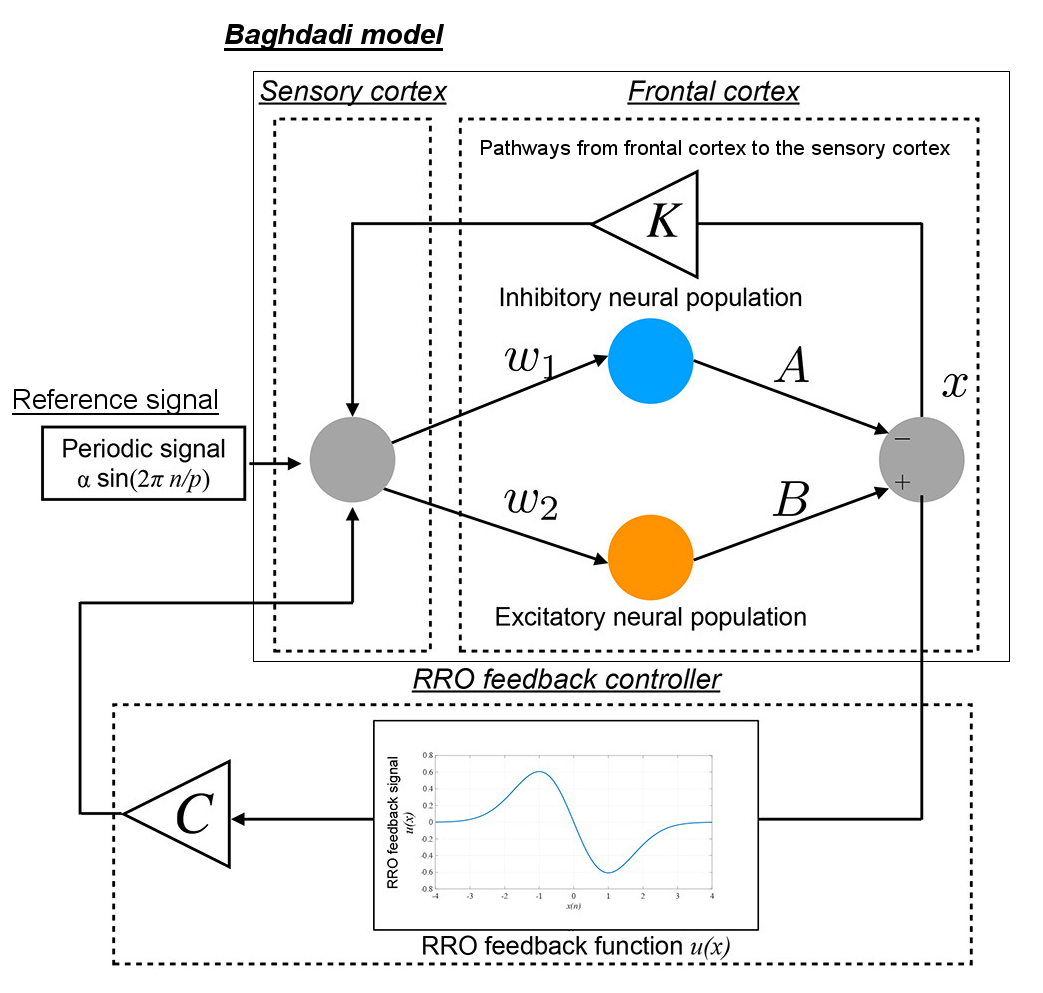

figure 1: Application of the reduced region of orbit (RRO) method to the Baghdadi model that simulates neurodynamics in ADHD
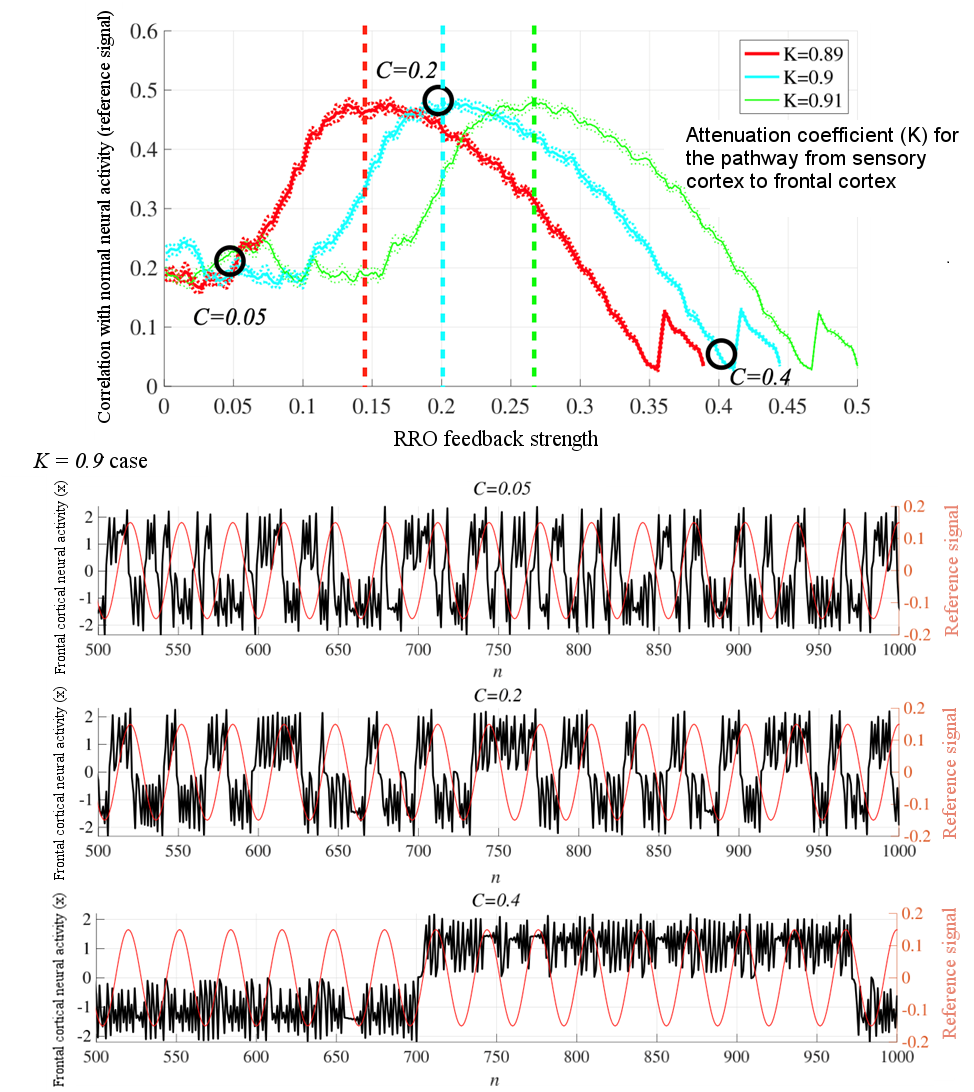

figure 2:Chaotic resonance achieved using the RRO method. Peaks of the correlation with normal neural activity (reference signal) (shown in the dotted line in the upper part of the figure) were achieved by appropriate RRO feedback. In other words, the normalization of disrupted neurodynamics in ADHD can be visualized.
READ MORE RESEARCH NEWS - SCIENCE
ACADEMICS
Undergraduate Programs
– Medicine
– Pharmaceutical Sciences
– Science
– Nursing
– Health Science
Graduate Programs
–Medicine
–Pharmaceutical Sciences
–Science
–Nursing
Undergraduate Programs
– Medicine
– Pharmaceutical Sciences
– Science
– Nursing
– Health Science
Graduate Programs
–Medicine
–Pharmaceutical Sciences
–Science
–Nursing
RESEARCH
– News
– Guidelines & Policies
– Support Offices
– Facilities
– Security Export Control
Non-Degree Programs
– Clinical Elective Program
– International Physician Observership Program

